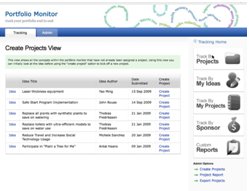How Software Can Turn Your Creativity into Products

A new trend in innovation management (aka ideation) platforms that I'm seeing I think will mark the beginning of the next generation of our industry. With them you'll be able to help your organizations move from creative brainstorming to implementation in a far easier and more effective way than today.
Up until now we've had platforms that were very proficient at pulling together the collective wisdom of employees, on the one hand, customers or external partners, on the other hand, or both. People will come together and through some process, be it predictive markets or through voting, will identify the best ideas.
If you're new to this whole space and don't believe just how successful it all can be, go check out the efforts being made by Dell, Starbucks, Cisco, and San Francisco to name a few.
Ok, very nice, so now you've identified "n" number of ideas that your group have deemed to be most likely to succeed. Now we can debate the process, the rating systems, the methodology, but put all of that aside for a second. All ideation platforms today bring you to this point. The question then is how do you act on those ideas? How do you move from idea concept to reality? And then how do you measure the success of those ideas?
Today most ideation platforms stop there. The tasks, assignments, project goals etc. needed to actually implement an idea are done outside of the platform. This makes it harder for innovation leaders and executives to understand the implementation costs and return of a given idea. It also complicates the process of identifying those individuals whose work have contributed the most to the ideas creation. I think where we're going to next is an end-to-end view where innovators can see from concept to implementation.
I don't think that most ideation platforms will try to morph into project management system - at least I hope not. Certainly vendors might start that ways, but fitting into and working with existing platforms and processes are critical.
Accept Software, for example, tied ideation into the product development lifecycle. Element8 is another firm who gets the big picture. Their Xpont architecture claims to plug into the overall lifecycle of bringing an idea or product to fruition.
But what happens when the ideas you're creating aren't specific to product development? I'm thinking of organizations like the city of San Francisco, where CIO Chris Vein led an ideation effort that uncovered various ways to improve the city, such as saving $75,000 in car washing. There's no product there per se. Just a change in process or methodology.
Ideation platforms are starting now to answer that need. Imaginatik's Bryan Mahoney and Alex Kevorkian , for example, showed me a new platform Imaginatik just released called Portfolio Monitor that will work with Imaginatik's ideation platform, IdeaCentral. As ideas reach a critical mass of popularity or perceived effectiveness in IdeaCentral, community managers or other select users, will be able to click on a button that will transfer the idea to Portfolio Manager for implementation. There you can track history and activity and follow the entire process in the implementation, Mahoney said. Email notifications and other ways of keeping people engaged throughout the process are present as well.
The release had these features covered:
I've clipped a few screens for you to see better as to what they're talking about:In addition to its reporting features and an intuitive user interface, Portfolio Monitor includes:
- Simple Integration Options – Move/upload ideas from Idea Central or other platforms directly to Portfolio Monitor.
- Standardized Project Workflow – Concepts that are converted into projects are simple to manage. Easily attach a custom, predefined process form, define project teams and assign required workflow to designated team members within Portfolio Monitor.
- Flexible Tracking – Predefined views include General Project Overview (organized by project status), Track by My Concepts (projects the user authored), Track by My Projects (projects in which the user is involved), Track by Sponsor (organized by sponsor name), and more.
- Easy Archive Access – Completed projects can be archived for future reference.
- Exporting Data – Export project data in CSV or Microsoft Excel format.
